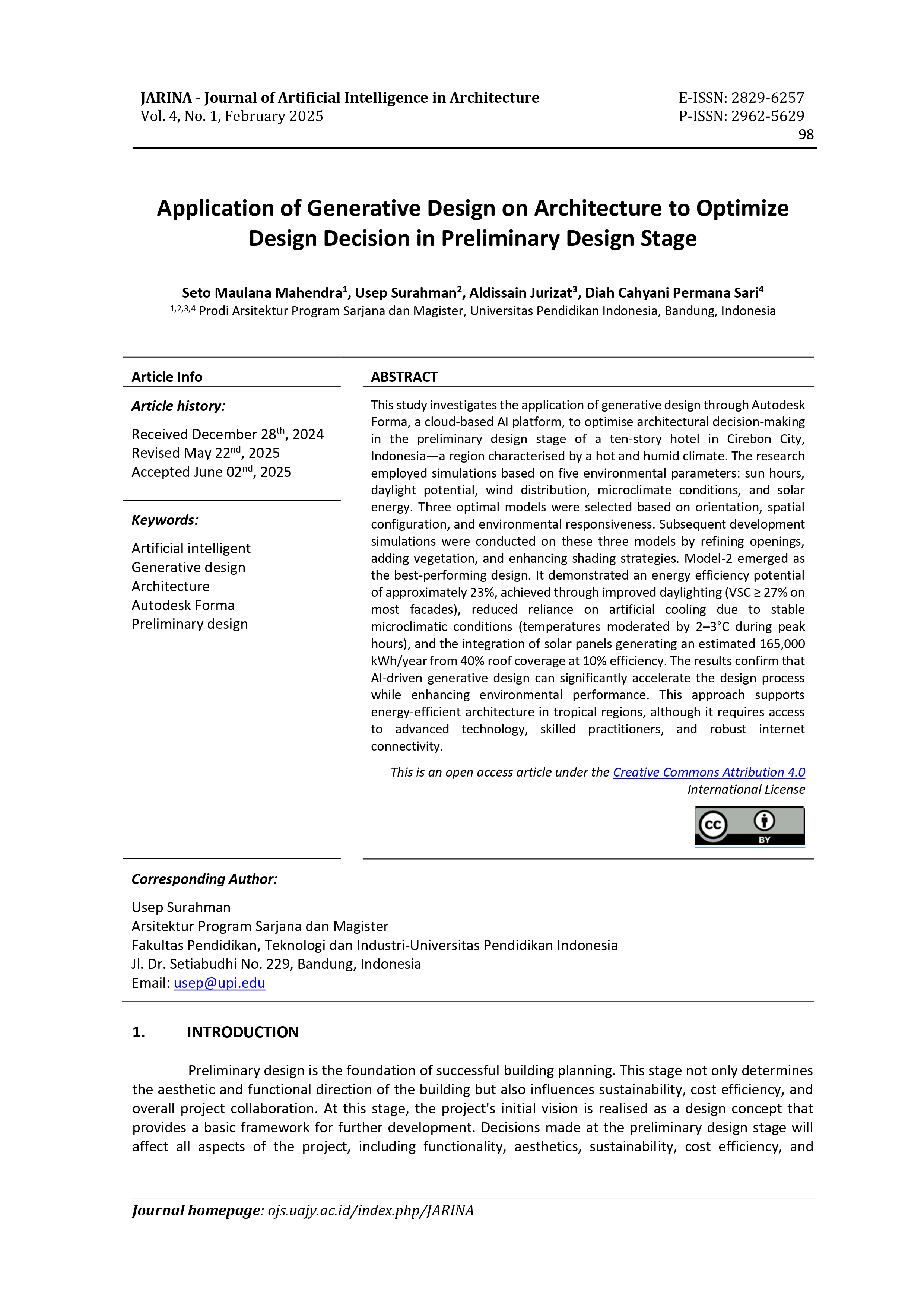Application of Generative Design on Architecture to Optimize Design Decision in Preliminary Design Stage
DOI:
https://doi.org/10.24002/jarina.v4i2.10557Keywords:
Artificial intelligent, Generative design, Architecture , Autodesk Forma, Preliminary designAbstract
This study investigates the application of generative design through Autodesk Forma, a cloud-based AI platform, to optimise architectural decision-making in the preliminary design stage of a ten-story hotel in Cirebon City, Indonesia—a region characterised by a hot and humid climate. The research employed simulations based on five environmental parameters: sun hours, daylight potential, wind distribution, microclimate conditions, and solar energy. Three optimal models were selected based on orientation, spatial configuration, and environmental responsiveness. Subsequent development simulations were conducted on these three models by refining openings, adding vegetation, and enhancing shading strategies. Model-2 emerged as the best-performing design. It demonstrated an energy efficiency potential of approximately 23%, achieved through improved daylighting (VSC ≥ 27% on most facades), reduced reliance on artificial cooling due to stable microclimatic conditions (temperatures moderated by 2–3°C during peak hours), and the integration of solar panels generating an estimated 165,000 kWh/year from 40% roof coverage at 10% efficiency. The results confirm that AI-driven generative design can significantly accelerate the design process while enhancing environmental performance. This approach supports energy-efficient architecture in tropical regions, although it requires access to advanced technology, skilled practitioners, and robust internet connectivity.
References
[1] F. D. K. Ching, Architecture: Form, Space, and Order. 2007.
[2] S. H. Khahro, D. Kumar, F. H. Siddiqui, T. H. Ali, M. S. Raza, and A. R. Khoso, “Optimizing energy use, cost and carbon emission through building information modelling and a sustainability approach: A case-study of a hospital building,” Sustain., vol. 13, no. 7, 2021, doi: 10.3390/su13073675.
[3] T. H. Dandan, G. Sweis, L. S. Sukkari, and R. J. Sweis, “Factors affecting the accuracy of cost estimate during various design stages,” J. Eng. Des. Technol., vol. 18, no. 4, pp. 787–819, Jan. 2020, doi: 10.1108/JEDT-08-2019-0202.
[4] Z. Yin, C. Caldas, D. de Oliveira, S. Kermanshachi, and A. Pamidimukkala, “Cross-functional collaboration in the early phases of capital projects: Barriers and contributing factors,” Proj. Leadersh. Soc., vol. 4, no. March, p. 100092, 2023, doi: 10.1016/j.plas.2023.100092.
[5] M. Parsamehr, U. S. Perera, T. C. Dodanwala, P. Perera, and R. Ruparathna, “A review of construction management challenges and BIM-based solutions: perspectives from the schedule, cost, quality, and safety management,” Asian J. Civ. Eng., vol. 24, no. 1, pp. 353–389, 2023, doi: 10.1007/s42107-022-00501-4.
[6] C. Ratti and M. Claudel, “The City of Tomorrow.” Yale University Press, 2016.
[7] R. Koenig, Y. Miao, A. Aichinger, K. Knecht, and K. Konieva, “Integrating urban analysis, generative design, and evolutionary optimization for solving urban design problems,” Environ. Plan. B Urban Anal. City Sci., vol. 47, no. 6, pp. 997–1013, 2020, doi: 10.1177/2399808319894986.
[8] N. L. Rane, S. P. Choudhary, and J. Rane, “Leading-Edge Technologies for Architectural Design: A Comprehensive Review,” Int. J. Archit. Plan., vol. 3, no. 2, pp. 12–48, 2023, doi: 10.51483/ijarp.3.2.2023.12-48.
[9] Z. X. Chew, J. Y. Wong, Y. H. Tang, C. C. Yip, and T. Maul, “Generative Design in the Built Environment,” Autom. Constr., vol. 166, no. July, p. 105638, 2024, doi: 10.1016/j.autcon.2024.105638.
[10] A. Mady and H. Mahmoud, “A Generative Design Approach to Improving the Environmental Performance of Educational Buildings in Hot Arid Climates . ( Assiut National University as a Case Study ),” vol. 10, no. 1, pp. 1–16, 2024, doi: 10.5334/fce.236.
[11] R. T. Hughes, L. Zhu, and T. Bednarz, “Generative Adversarial Networks – Enabled Human – Arti fi cial Intelligence Collaborative Applications for Creative and Design Industries : A Systematic Review of Current Approaches and Trends,” vol. 4, no. April, pp. 1–17, 2021, doi: 10.3389/frai.2021.604234.
[12] “Autodesk Forma | Forma Login | Software Price & Buy.” https://www.autodesk.com/products/forma/overview (accessed Jul. 17, 2025).
[13] A. Fitriawijaya, “Integrating Multimodal Generative AI and Blockchain for Enhancing Generative Design in the Early Phase of Architectural Design Process,” Buildings, vol. 14, no. 2533, pp. 1–20, 2024, doi: https://doi.org/10.3390/buildings14082533.
[14] M. A. Abbas, S. O. Ajayi, A. S. Oyegoke, and H. Alaka, “A cloud-based collaborative ecosystem for the automation of BIM execution plan (BEP),” J. Eng. Des. Technol., vol. 22, no. 4, pp. 1306–1324, Jan. 2024, doi: 10.1108/JEDT-02-2022-0128.
[15] Badan Pusat Statistik Kota Cirebon, “Cirebon dalam Angka 2024,” vol. 49, 2024.
[16] M. Shi, J. Seo, S. H. Cha, B. Xiao, and H.-L. Chi, “Generative AI-powered architectur al exterior conceptual,” J. Comput. Des. Eng., vol. 11, no. September, pp. 125–142, 2024, doi: 10.1093/jcde/qwae077.
[17] J. Ko, J. Ajibefuna, and W. Yan, “Experiments on Generative AI-Powered Parametric Modeling and BIM for Architectural Design,” pp. 1–18.
[18] C. A. Faulkner et al., “Fast prediction of indoor airflow distribution inspired by synthetic image generation artificial intelligence,” Build. Simul., vol. 16, no. 7, pp. 1219–1238, 2023, doi: 10.1007/s12273-023-0989-1.
[19] N. Mohammed, A. E.- Maksoud, and E. B. Ahmed, “Artificial Intelligence Applications in Green Architecture,” vol. 7, no. 2, pp. 317–337, 2024, doi: 10.21608/fuje.2024.345049.
[20] A. Ayman, Y. Mansour, and H. Eldaly, “Generative vs . Non-Generative AI : Analyzing the Effects of AI on the Architectural Design Process,” no. April, pp. 119–128, 2024.

Downloads
Published
How to Cite
Issue
Section
License
Copyright (c) 2025 Seto Maulana Mahendra, Usep Surahman, Aldissain Jurizat, Cahyani Permana

This work is licensed under a Creative Commons Attribution 4.0 International License.
Authors who publish with this journal agree to the following terms:
1.Authors retain copyright and grant the journal right of first publication with the work simultaneously licensed under a Creative Commons that allows others to share the work with an acknowledgement of the work's authorship and initial publication in this journal.
2.Authors are able to enter into separate, additional contractual arrangements for the non-exclusive distribution of the journal's published version of the work (e.g., post it to an institutional repository or publish it in a book), with an acknowledgement of its initial publication in this journal.
3.Authors are permitted and encouraged to post their work online (e.g., in institutional repositories or on their website) prior to and during the submission process, as it can lead to productive exchanges, as well as earlier and greater citation of published work (See The Effect of Open Access).
















